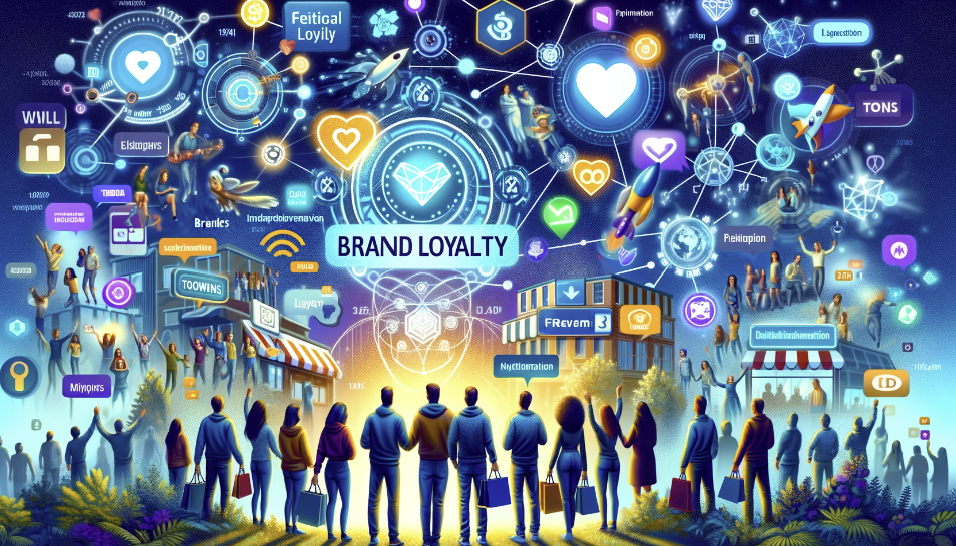From Consumers to Creators: The Rise of Web3 and Its Influence on Brand Loyalty
Introduction to the Shift in Consumerism
In a world where consumer voices resonate louder than ever before, the landscape of customer engagement has undergone a profound transformation. Gone are the days when consumers were mere spectators in the realm of commerce and branding. Today, they stand at the forefront, actively participating and influencing the brands they interact with. This seismic shift from passive consumerism to active participation marks a new era in how customers relate to and shape the products and services they love.
The metamorphosis of consumer roles is inextricably linked to the evolution of technology. Advancements in digital platforms have not only enhanced the accessibility of information but have also empowered consumers to voice their opinions, preferences, and ideas more loudly and clearly than ever. In this dynamic environment, a pivotal player has emerged as a cornerstone of change: Web3.
Web3, with its decentralized ethos and emphasis on user empowerment, is reshaping the foundations of customer-brand interactions. It extends beyond the mere transactional relationship of buying and selling, fostering a deeper sense of ownership, collaboration, and community among consumers. This technological leap is not just a tool but a catalyst, accelerating the transition towards more meaningful and engaged consumer-brand relationships.
As we delve deeper into this transformative era, it’s crucial to understand the nuances of this shift. From the definition and implications of Web3 to its profound impact on customer loyalty and brand narratives, this article aims to explore the multifaceted nature of this evolution. We will examine case studies, challenges, opportunities, and future predictions, providing a comprehensive view of how Web3 is crafting a new narrative in the world of consumer-brand dynamics.
Join us as we embark on this journey, exploring how the rise of Web3 is redefining the landscape of brand loyalty, turning consumers from passive observers into active creators and participants in the brands they cherish.
Exploring Web3: A New Frontier for Customer Engagement
In the ever-evolving digital landscape, Web3 emerges as a groundbreaking development, radically altering how customers interact with and influence brands. This section delves into the essence of Web3, shedding light on its characteristics and the unique ways it fosters customer engagement.
Defining Web3 and Its Key Characteristics
Web3 represents the next phase of the internet’s evolution, characterized by decentralization, blockchain technology, and a strong emphasis on user sovereignty. Unlike its predecessor, Web3 is not controlled by centralized entities but is powered by a network of users. This decentralization ensures greater transparency, security, and user control, redefining the dynamics of online interactions and transactions.
A pivotal aspect of Web3 is its reliance on blockchain technology. Blockchain, with its immutable ledger and smart contract capabilities, offers an unprecedented level of trust and verification in online transactions. This technology is not just a tool for financial transactions but extends to areas like identity verification, content authenticity, and more, paving the way for a new era of digital integrity.
How Web3 Enhances Customer Interactivity and Involvement
Web3’s influence on customer engagement is multifaceted. Firstly, it empowers customers to have a more significant say in the products and services they use. Through decentralized platforms and community governance models, customers can vote on product features, participate in brand decisions, and even co-create products, ushering in a new age of collaborative innovation.
Secondly, Web3’s tokenization capabilities enable brands to reward customers in more meaningful ways. Beyond traditional loyalty points, blockchain-based tokens can offer customers a stake in the brand’s success, aligning the interests of the company and its consumers closer than ever. These tokens can also be used to access exclusive content, events, or experiences, enhancing the sense of belonging and loyalty.
Finally, Web3 facilitates a more personalized and secure customer experience. With decentralized identity solutions, customers can control their data, choosing what to share and with whom. This heightened control not only enhances privacy but also allows for more tailored interactions between brands and consumers, based on the willingly shared preferences and interests of the latter.
The Transformation of Brand Loyalty in the Web3 Era
The advent of Web3 is not just redefining customer engagement; it’s also reshaping the very nature of brand loyalty. This section explores how Web3 is transforming customer loyalty, backed by real-world examples and psychological insights.
Case Studies of Brands Leveraging Web3 for Enhanced Customer Loyalty
In the realm of Web3, several forward-thinking brands have already begun experimenting with innovative strategies to boost customer loyalty. For instance, a luxury fashion brand recently launched a blockchain-based loyalty program, offering exclusive digital collectibles as rewards. These collectibles are not just mere tokens but represent a unique form of brand engagement, offering customers a tangible stake in the brand’s narrative and future.
Another example is a major tech company that has integrated decentralized identity solutions into its customer relationship management. By doing so, they have given customers control over their data, leading to increased trust and a more personalized brand experience. This approach demonstrates how respect for customer privacy in Web3 can translate into deeper brand loyalty.
The Psychology Behind Increased Loyalty through Customer Participation
The shift towards Web3 is closely linked to fundamental psychological principles. When customers are actively involved in shaping a product or a brand, they develop a sense of ownership and investment in its success. This phenomenon, known as the ‘IKEA effect’, implies that the more effort one puts into creating something, the more value and attachment one feels towards it.
Moreover, Web3’s emphasis on community and shared ownership aligns with the human need for belonging and social identity. Brands that leverage Web3 to create a sense of community among their customers are tapping into this powerful psychological driver, fostering a deeper emotional connection and loyalty.
In conclusion, Web3’s influence on brand loyalty extends far beyond technology. It touches on fundamental human needs and behaviors, providing brands with an opportunity to engage with their customers in more meaningful and rewarding ways.
Challenges and Opportunities for Brands in Web3
As we navigate through the Web3 era, brands face both challenges and opportunities. This section will explore these aspects, offering insights into how brands can effectively adapt and thrive in this new landscape.
Navigating the Challenges Posed by a More Empowered Consumer Base
The empowerment of consumers in Web3 presents unique challenges for brands. One significant challenge is the need for transparency and authenticity. In a decentralized world where consumers have greater control and insight, brands need to be more open about their processes, values, and commitments. This shift requires a reevaluation of traditional marketing strategies, focusing more on building genuine relationships rather than just pushing sales.
Another challenge is the technological adaptation required. Embracing Web3 means investing in new technologies and platforms, which can be daunting for businesses not familiar with blockchain and decentralized systems. There’s also the challenge of ensuring security and privacy in these new environments, which is crucial in maintaining customer trust.
Harnessing the Opportunities Web3 Presents for Customer Loyalty
Despite the challenges, Web3 offers immense opportunities for brands to foster deeper loyalty. One such opportunity is the creation of unique customer experiences. Through NFTs (Non-Fungible Tokens), brands can offer exclusive content, access, or products, making customer engagement more personalized and memorable.
Web3 also allows for innovative loyalty programs. Unlike traditional points systems, blockchain-based tokens can offer real value, potentially even appreciating over time. This not only incentivizes customers to stay engaged but also gives them a stake in the brand’s success.
Furthermore, the decentralized nature of Web3 fosters a sense of community among customers. Brands that successfully create and nurture these communities can benefit from a more engaged and loyal customer base, willing to advocate for and contribute to the brand’s growth.
In conclusion, while Web3 introduces complexities, it also opens up a world of possibilities for brands to connect with their customers in more meaningful ways. Those who navigate these waters wisely will not only survive but thrive in the era of empowered consumerism.
Looking Forward: The Future of Consumer-Brand Relationships in Web3
As we venture further into the Web3 era, it’s crucial to contemplate the future dynamics of consumer-brand relationships. This concluding section offers predictions and strategies for brands to navigate and excel in this evolving landscape.
Predictions for the Evolving Landscape of Customer Loyalty
The future of customer loyalty in the Web3 world is likely to be characterized by even more profound levels of interaction and personalization. We can expect to see a surge in brands offering more than just products or services; they will be offering experiences, communities, and a sense of belonging. This will not only increase customer retention but also transform customers into brand advocates.
The use of AI and machine learning in conjunction with blockchain technology will enable brands to offer highly personalized experiences at scale. This could mean personalized rewards, products, or even marketing messages, all tailored to the individual preferences and behaviors of customers.
Furthermore, as Web3 technologies become more mainstream, we will likely witness a democratization of brand building. Customers will not only be consumers but also co-creators, playing a significant role in shaping products, services, and brand narratives.
Strategies for Brands to Stay Ahead in the Web3 Era
To thrive in the Web3 era, brands need to adopt a proactive approach. Firstly, investing in understanding and integrating Web3 technologies is crucial. This includes not just blockchain but also related technologies like AI, IoT, and AR/VR, which can enhance customer experiences.
Building and nurturing online communities will be another key strategy. These communities can serve as valuable feedback loops and innovation hubs, where customers feel heard and valued. Engaging with customers through these platforms in an authentic and transparent manner will be vital.
Lastly, brands need to be agile and adaptable. The Web3 landscape is evolving rapidly, and what works today might not work tomorrow. Staying informed about emerging trends, listening to customer needs, and being willing to experiment will be essential for long-term success.
In conclusion, the rise of Web3 marks a significant shift in consumer-brand relationships. Embracing this change and leveraging its potential will be crucial for brands aiming to build lasting loyalty and relevance in the digital age.






